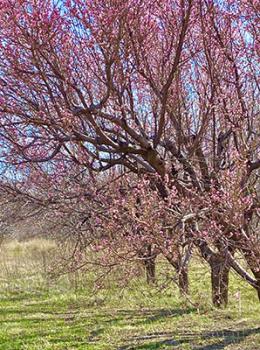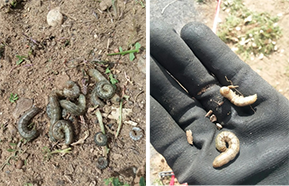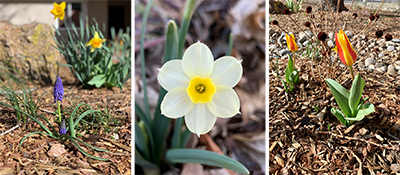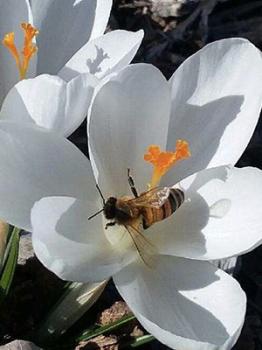March 21, 2020
Rarin’ to Grow: Get Outside and Show Those Weeds Who’s Boss
March 21, 2020

With many of us spending more time at home this spring than ever, we’re getting more questions on how to start gardening from people who’ve never gardened before. I’m excited for these gardening newbies. As seasoned gardeners will tell you, gardening can relax and reinvigorate you when seemingly nothing else can. One of my favorite bumper stickers is “Gardening is cheaper than therapy—and you get tomatoes.” And a favorite meme from this week states simply: “The answer is plants. Don’t care what the question is.”
Watering my houseplants makes me feel calm and accomplished. I’ve finally figured out which plants can handle living up on the high shelf in my sun room where I only get around to watering them once a month or so. These troopers include sansevierias (aka snake plants or mother-in-law’s tongues), a red bird from my Aunt Ginger (a euphorbia closely related to the zig-zag-stemmed devil’s backbone), a purple queen (aka wandering Jew, spiderwort, or flowering inch plant), a string-of-bananas, two spider plants (aka airplane plants), pothos, split-leaf philodendrons, crown-of-thorns, and lots and lots of succulents.
But in these anxious times, maybe I need houseplants that can take some extra water. I’ve spent most of my plant-loving years carefully selecting houseplants that can handle and even thrive in severe neglect, but now all I want to do is water them again and again. Years ago, when working at an Albuquerque nursery, I had a customer come in needing a houseplant for her mother who had Alzheimer’s and couldn’t stop watering her plants. In addition to selecting a peace lily, Selaginella (aka spikemoss), baby’s tears, and a Cyperus alternifolius (umbrella palm), I suggested finding a teensy tiny watering can. Maybe that’s what I’ll do this month while teleworking: water three times a day with a shot glass.

Aside from watering my houseplants, the highlights of my last two weeks all took place in one garden or another. At the NMSU Agricultural Science Center at Los Lunas, where I work, I was delighted by hundreds of tomato and artichoke plants that were planted by Ph.D. student Chuck Havlik and just sprouted in our greenhouse.
In addition to several varieties of cherries, apricots, plums, apples, quince, pears, and pomegranates, we have 92 peach trees (23 different cultivars) at the research farm, and I’ve been tracking the dates of first bloom since the beginning of the month, which means I get to stare at and photograph bursting buds, beautiful blossoms, and buzzing bees every day. The worrisome news is that many of the trees are already in full bloom or past it. The ‘Goldrich’ apricots bloomed before March 1. The ‘Methley’ and ‘Santa Rosa’ plums bloomed right after, as did over half the peach varieties. We’re worried about losing this year’s fruit to freezes that are likely still to come. But what’s worse, according to records we have on these trees’ bloom dates going back to 2008, they’re all blooming 10–20 days earlier than 12 years ago. Wait. Let’s not grow there, not today.
In our pollinator habitat Learning Garden at the Ag Science Center two weeks ago, our high school intern and I weeded the plots in my very exciting mulch study. While weeding, Mellene and I found dozens of chubby grubs just under the soil surface and brightly colored bugs hiding at the base of London rocket weeds. At the time, I wasn’t sure what they were, so we just let them be. I now know that we should have killed them on the spot because they were the dreaded cutworm caterpillar (not a true grub) and harlequin bug. Next time I’ll have a container of soapy water ready, not for washing my hands but for drowning these prolific pests.

On a happier note, we’re also growing ornamental bulbs, such as crocus, daffodils, and Dutch iris, to see if they provide early forage (pollen) and habitat for important pollinators. This work entails staring at experimental stands of flowers for 10-minute intervals and recording how many and what types of insects visit each flower. You can imagine how this made it onto my list of gardening highlights.
I’ll share links to topics I’ve mentioned in this column as well as helpful garden-starting resources, and also share photos of the fruit tree blossoms, bulbs, and my favorite houseplants this week! Check it out at Desert Blooms. Share your garden highlights (and lowlights) with me on social media by tagging @NMDesertBlooms or emailing photos to desertblooms@nmsu.edu.
Remember, above all, to have patience with your garden and yourselves. This week I hastily ripped up and discarded an ailing tree that wasn’t mine and could have stood a chance with a little TLC. I also lost my patience with a colleague over email miscommunications. It’s okay if we make mistakes. That’s how we grow.

Marisa Y. Thompson, PhD, is the Extension Horticulture Specialist, in the Department of Extension Plant Sciences at the New Mexico State University Los Lunas Agricultural Science Center, email: desertblooms@nmsu.edu, office: 505-865-7340, ext. 113.
Links:
For more gardening information, visit the NMSU Extension Horticulture page at Desert Blooms and the NMSU Horticulture Publications page.
Send gardening questions to Southwest Yard and Garden - Attn: Dr. Marisa Thompson at desertblooms@nmsu.edu, or at the Desert Blooms Facebook page.
Please copy your County Extension Agent and indicate your county of residence when you submit your question!